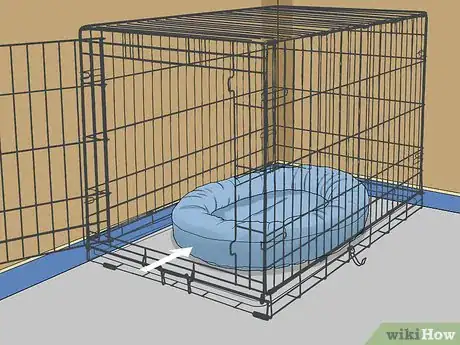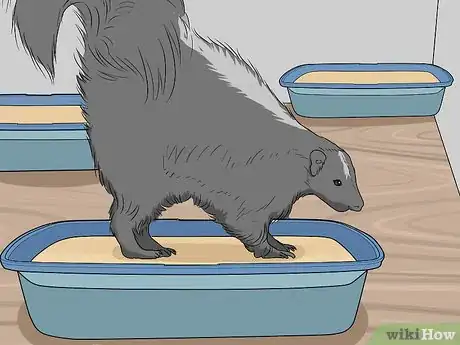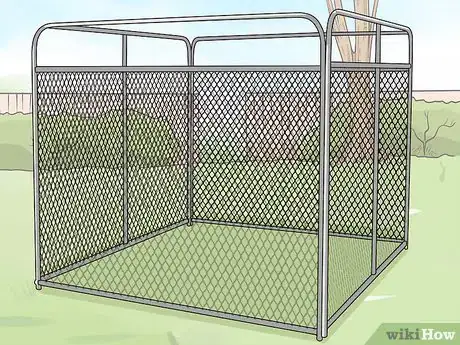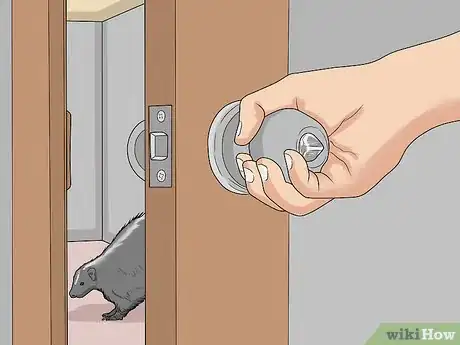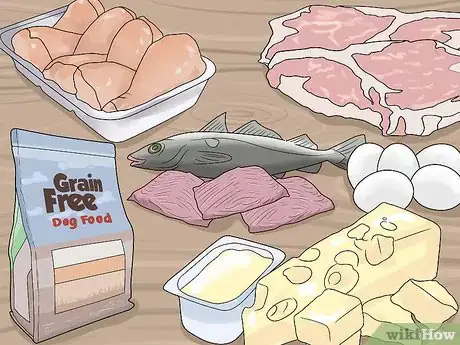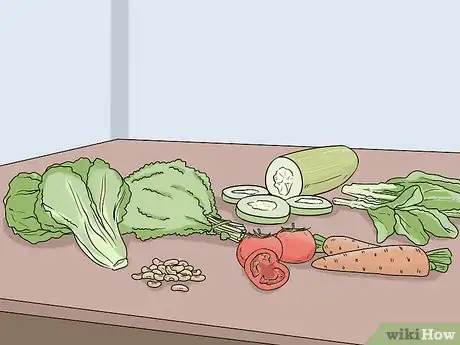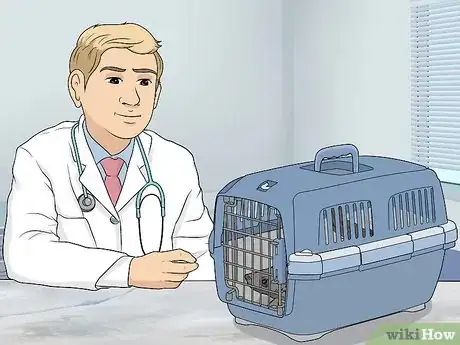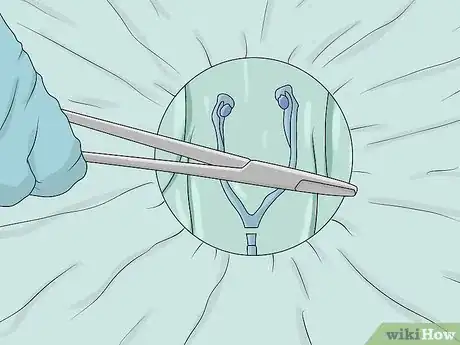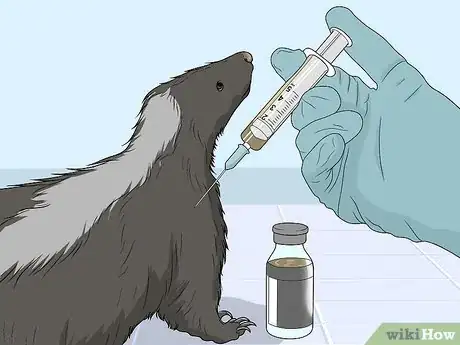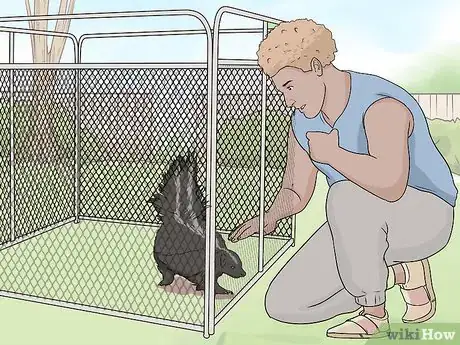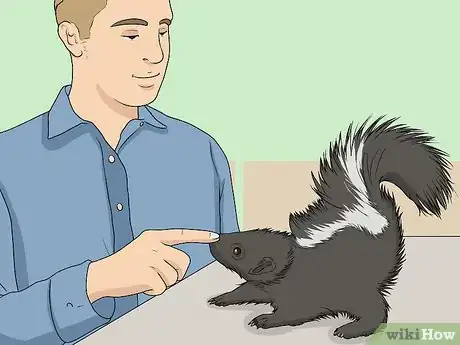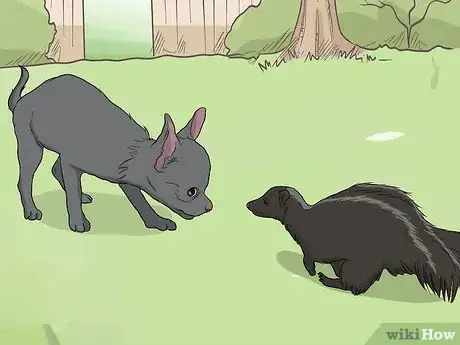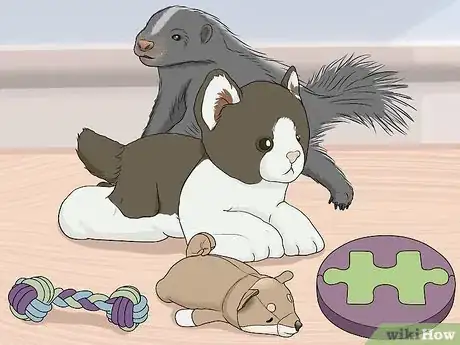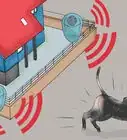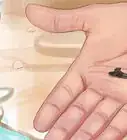This article was co-authored by wikiHow Staff. Our trained team of editors and researchers validate articles for accuracy and comprehensiveness. wikiHow's Content Management Team carefully monitors the work from our editorial staff to ensure that each article is backed by trusted research and meets our high quality standards.
There are 9 references cited in this article, which can be found at the bottom of the page.
This article has been viewed 26,907 times.
Learn more...
Skunks can be great pets if you get a domesticated one that has come from a breeder. Once you have a pet skunk, you need to learn how to care for it properly. Proper care includes housing it, feeding it, and keeping it happy and healthy. This will take some daily effort on your part but with proper care in these four areas you will enjoy your pet skunk for years to come.
Steps
Setting up the Habitat
-
1Buy a crate for your skunk. Before you obtain your little pet skunk, go to a local pet shop and pick out a large dog crate for it. Pick the biggest one that will fit in your home, so that your skunk will have room to move around in it.[1]
- Get a crate that is made for extra large dog breeds. These crates are usually about 4 feet (1.2 m) deep, 3 feet (0.91 m) wide, and 4 feet (1.2 m) tall. The cage should be big enough to hold a bed, toys, and a litter box.
- Skunks naturally live in dens, so the crate will serve as its den.
Tip: While you don’t want to keep your skunk caged up while you are home, a crate will keep it safe and secure when you are out of the house.
-
2Get a pet bed that fits inside the crate. Give your skunk a soft, cushioned place to sleep when it is in its crate. Pick out a bed that is machine washable, as you will want to wash it every week or two.[2]
- Don't spend a ton of money on your skunk’s bed. It’s likely that the animal will destroy it with their claws, so you will need to replace the bed on a regular basis.
Advertisement -
3Get several litter boxes for your skunk. Your skunk can be trained to use a litter box just like a cat. Get several low-sided pans, like those made for ferrets, and put one in the corner of your skunk’s cage and the others in the rooms where your skunk spends its time. Introduce your skunk to a litter box and they will remember where it is when they need to go to the bathroom.[3]
- Litter training a skunk can take a bit longer than it does with a cat. However, keep trying and your skunk is likely to get the hang of it.
- Put the litter boxes in the corner of rooms and the cage. Skunks tend to go to the bathroom in the corner of rooms.
Tip: If your skunk is going to the bathroom in an area without a litter box repeatedly, clean the area and then place a litter box there.
-
4Create an outdoor pen or cage, if you have space for one. Skunks love to spend time outside, so it’s nice to create a space where they can do that. If you plan on letting your skunk stay out there when you are not around, you will need a secure cage. If you just want an area where your skunk can explore while you supervise, a pen will work well.[4]
- Ideally, an outdoor pet would be at least 6 feet (1.8 m) long, 6 feet (1.8 m) wide, and 3 feet (0.91 m) tall.
- There are commercial outdoor skunk cages and pens available from online retailers.
- If you want to use a cage to keep your skunk outside, it needs to have a welded metal bottom and top on it. Skunks are good at chewing through wood and can sneak out through small spaces, so the cage needs to be very secure.[5]
-
5Pick an area of your home for your skunk and skunk proof it. Pick a room or several rooms that have hard floors covered in wood, tile, or linoleum. This will make it easier for you to clean. Also remove hazards and items that could be destroyed, such as electrical cords, trashcans, and cleaning products.[6]
- Put locks on cupboards you don’t want your skunk getting into.
- Ensure that doors and windows to the outside are secured before letting your skunk roam.
-
6Introduce your pet skunk to its area slowly. Sometimes skunks get overwhelmed by lot of changes. To prevent this, keep your new skunk confined to one room of your home. Give it a few days to get used to that room and then slowly let the skunk explore other rooms, if you like.
-
7Keep your skunk contained in your home. Don’t allow your skunk to escape from your home or it could get injured or lost. Make sure all doors are closed and latched at all times if your skunk is allowed to you're your home. Also check that window screens are secured, as skunks can push through them on occasion.[7]
- Unlike cats and dogs, domesticated skunks lack homing instincts to find their way back. They can also travel very fast, so your skunk may be gone forever if it gets loose.
Feeding Your Skunk
-
1Give your skunk mostly raw or cooked lean proteins. This can include a combination of chicken, eggs, dairy, fish, grain-free dog food, and feeder animals and insects. These lean proteins should make up about 70% of your skunk’s diet.[8]
- Eggs and meat can be given raw or cooked. It’s a good idea to figure out which your skunk prefers and stick with that.
- Feeder insects and animals to give your skunk include crickets, mealworms, worms, and frozen pinkie mice.
- You can buy specialty skunk food online, if you need an easy way to feed your skunk. However, it will be much more expensive and not any more nutritious than making your own.
- Do not feed your skunk cat food. It isn't good for them because it’s too high in fat and protein.[9]
-
2Mix fresh vegetables into your skunk’s meals. Cut up into small pieces, but don't peel, a variety of uncooked vegetables for your skunk. They should make up 30% of your skunk’s meals. They can include, but are not limited to:[10]
- Broccoli
- Cauliflower
- Zucchini
- Bell peppers
- Peas
- Carrots
- Turnips
- Beets
- Cucumbers
- Tomatoes
- Eggplant
- Green beans
- Spinach
- Kale
- Cabbage
- Lettuce
-
3Add additional ingredients that round out the skunk's diet. There are a variety of other ingredients that can be given to your skunk to give them vital nutrients. These ingredients shouldn’t be given every day but are great to rotate into your skunk’s meals. Some options include:
- Fruits: Give apples, berries, pears, and strawberries but only as a treat. It should only be added to your skunk’s diet about once a week. Also, don't feed your skunk grapes because they are toxic and can make your skunk sick.
- Nuts and seeds: These give your skunk healthy fatty acids, which help its coat.
- Supplements: Including calcium, vitamin D, and Taurine. Check with your vet before adding any of these to your skunk’s diet. Typically, you will give them to your skunk once a week.
-
4Feed your skunk about 1/2 cup (100g) of food several times a day. If you have an adult skunk, you simply need to give it a meal in the morning and a meal in the evening. Put the food in a pet food bowl and let your skunk work through it at its own pace.[11]
- Each meal should consist of ½ to 1 cup (100 to 200g) of a mixture of vegetables, lean protein, and additional varying ingredients of your choice, such as dairy, grains, or fruit.
- Very young skunks need about 5 small meals a day to thrive. However, as a skunk grows up, you can feed them less often.
-
5Provide a constant source of fresh water. Skunks need to have access to water at all times so that they don't become dehydrated. Put out a fresh bowl of water every day and make sure to use a clean bowl when you do.[12]
- It's a good idea to put a tray or towel under the bowl, as skunks can be messy drinkers.
Tip: Skunks don’t always drink a lot of water. However, it’s important that it is available for them all of time.[13]
Keeping Your Skunk Healthy
-
1Find a vet in your area that treats skunks. It can be hard to find a vet that knows how to treat skunks, especially if there are only a few vets in your area. Contact the vets in your area and ask them if they treat skunks. The ideal is to get a vet that has experience treating skunks but you may need to settle for a vet that is willing to learn and try.[14]
- You may need to travel quite far to find a vet that will treat your skunk. However, it’s important to find the nearest one so that you know where to take your skunk in an emergency.
-
2Have your skunk spayed or neutered when it is 4 to 6 months old. It’s important to get your skunk fixed so that it doesn’t have the ability to reproduce, unless you are planning on breeding it. Spaying and neutering also prevents negative behavioral changes in the animals because they will become focused on mating.[15]
- Getting females spayed also prevents them from bleeding all over your home when they are in heat.
-
3Make sure your skunk was de-scented when it was a baby. Domesticated skunks should be de-scented when they are between 2 and 5 weeks old. If you are not breeding skunks yourself, this means that the skunk should already be de-scented when you get it. Talk to your breeder about the procedure to ensure that it has been done to your skunk.[16]
- During this surgery their musk or scent glands are removed.
- This will ensure that they don't spray all over your house, including at you.
Tip: Since their scent is their basic defense mechanism, having a skunk de-scented means that it would never survive in the wild. It will need to be cared for as a pet for the rest of its life.
-
4Get the skunk dewormed and immunized, if necessary. If your skunk has not had quality veterinary care in the past, it may have worms and it may need vaccinations when you get it. Talk to your veterinarian about this and also ask the person you got the skunk from whether it has had these treatments.[17]
- Skunks should be vaccinated for distemper and rabies. Your veterinarian may suggest other vaccinations as well, depending on where you live and what infections are common in that area.
- It’s important to get these foundational medical treatments for your skunk before letting it wander around in your home and interact with other pets you might have.
- Talk to your vet about a vaccination schedule for your skunk. It will need boosters and continued care after its first visit.
Ensuring That Your Skunk is Happy
-
1Spend time with your skunk so it gets to know you. When you get a new pet skunk, don’t expect it to trust you right away. Show it that you are trustworthy by spending time with it and treating it well. Spend time sitting outside of its cage, giving it treats, and speaking sweetly to it.[18]
- Skunks have been known to bite. However, if you spend time with them and they get used to you, this shouldn't happen.
- Skunks can't be de-clawed like a cat, so watch out for scratching it gets used to you.
-
2Don’t let your skunk spend all of its time alone. Skunks are social animals that don't do well in isolation. This can cause anxiety issues and aggression. Instead, spend time with your pet every day.[19]
- If you are going to be gone for several hours, spend time with your skunk before you leave the house.
- Cuddle with it, play with it, and just be there for it.
Tip: Skunks have been known to feel neglected when not paid attention to. If your skunk starts acting out, it may just be that you need to spend more time with it.
-
3Allow your skunk to play with your other animals if they both enjoy it. If you have other pets and they seem to get along with your skunk, then let them interact. Be cautious at first, as skunks tend to play differently and rougher than cats and dogs, but let them get to know each other and form a bond.
- Ensure that your skunk has been immunized before letting it interact with your other pets.[20]
- This can be great for keeping both your skunk and other pets occupied but they should not be left together while you are gone.
-
4Give your skunk toys to play with. Skunks are active animals that do well with mental and physical stimulation. Give your skunk a variety of dog toys, such as stuffed animals, rope chew toys, and food puzzle toys. These items are especially important for giving the animal something to do while you are gone.
- Do not give your skunk rawhide chew toys.
Community Q&A
-
QuestionWhat do I feed baby skunks?
 Annalise FransenCommunity AnswerFeed the baby skunk esbilac powder, and mix only enough for 24 hours and keep it refrigerated. Esbilac is a puppy milk replacer, which you should be able to purchase at a vet or pet store. Cow's milk, human baby formulas, and most pet products (except Esbilac) are not suitable and will likely cause death.
Annalise FransenCommunity AnswerFeed the baby skunk esbilac powder, and mix only enough for 24 hours and keep it refrigerated. Esbilac is a puppy milk replacer, which you should be able to purchase at a vet or pet store. Cow's milk, human baby formulas, and most pet products (except Esbilac) are not suitable and will likely cause death. -
QuestionHow can I stop my skunk from farting?
 Community AnswerPassing gas is natural, you can't stop them from doing it as much as you can stop doing it yourself. If you mean emptying his scent glands, or spraying, you can have an experienced vet remove the glands. Make sure the vet you use is familiar with treating skunks.
Community AnswerPassing gas is natural, you can't stop them from doing it as much as you can stop doing it yourself. If you mean emptying his scent glands, or spraying, you can have an experienced vet remove the glands. Make sure the vet you use is familiar with treating skunks. -
QuestionWhy does this article portray skunks to be such bad pets?
 Community AnswerBecause exotic, wild animals should be in the wild, and are hard to take care of.
Community AnswerBecause exotic, wild animals should be in the wild, and are hard to take care of.
Warnings
- Before getting a skunk, research whether it's legal to keep a skunk in your state or municipality. In some areas, keeping a skunk is illegal.[21]⧼thumbs_response⧽
- Buy your skunk from a licensed breeder. Buying from backyard breeders encourages bad breeding practices and you could be buying a wild skunk that has been taken illegally.[22]⧼thumbs_response⧽
- Do not let anyone other than you and your direct family interact with your skunk. If the skunk bites them, some municipalities will require that the skunk is killed to test it for rabies, even if it has been vaccinated.[23]⧼thumbs_response⧽
Things You'll Need
Housing Your Skunk
- Large dog crate
- Pet bed
- Outdoor pen, if possible
- Litter box
- Litter
Feeding Your Skunk
- Lean proteins, such as chicken, eggs, dairy, and fish
- Vegetables
- Small amounts of fruit, nuts, seeds, and supplements
- Food bowl
- Water
- Water bowl
Keeping Your Skunk Healthy
- Veterinarian
- Vaccines
Ensuring That Your Skunk is Happy
- Toys
References
- ↑ https://www.exoticanimalsforsale.net/articles/pet-skunk-care-sheet.asp
- ↑ https://www.skunkhaven.net/NewSkunk.htm
- ↑ https://www.skunkhaven.net/PetSkunks.htm
- ↑ https://www.skunkhaven.net/NewSkunk.htm
- ↑ http://www.orphanedwildlifecare.com/skunkcare.htm
- ↑ https://www.skunkhaven.net/NewSkunk.htm
- ↑ https://www.pbs.org/wnet/nature/is-that-skunk-do-skunks-make-good-pets/4569/
- ↑ https://animals.mom.me/natural-diet-captive-skunks-7562.html
- ↑ https://www.skunkhaven.net/DietNutrition.htm
- ↑ https://www.skunkhaven.net/DietNutrition.htm
- ↑ https://www.skunkhaven.net/DietNutrition.htm
- ↑ https://www.skunkhaven.net/DietNutrition.htm
- ↑ http://skunkvetcare.org/diet
- ↑ https://skunkhaven.net/BasicSkunkCare.htm
- ↑ https://skunkhaven.net/BasicSkunkCare.htm
- ↑ https://www.pbs.org/wnet/nature/is-that-skunk-do-skunks-make-good-pets/4569/
- ↑ http://www.orphanedwildlifecare.com/skunkcare.htm
- ↑ https://www.skunkhaven.net/NewSkunk.htm
- ↑ https://www.skunkhaven.net/NewSkunk.htm
- ↑ https://www.skunkhaven.net/NewSkunk.htm
- ↑ https://skunkhaven.net/BasicSkunkCare.htm
- ↑ https://skunkhaven.net/BasicSkunkCare.htm
- ↑ https://www.skunkhaven.net/PetSkunks.htm

